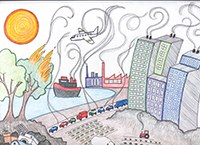Air

The air pollution is produced by the indoor or outdoor environmental contamination by chemical, physical or biological agents that modify the natural characteristics of the atmosphere. The machine for the homes heating, the engines of vehicles, industrial plants and forest fires are common sources of air pollution. Pollutants that have great impacts on public health are particulate matter (PM10), carbon monoxide (CO), ozone (O3), nitrogen dioxide (NO2) and sulfur (SO2).
Air pollution is harmful to human health and the environment. In Italy, emissions of many air pollutants have significantly decreased in recent decades, with consequent improvement of air quality; however, the concentrations of air pollutants are still too high and the air quality pollution persist. This also happens because the report between emissions (what comes from car exhaust pipes or chimneys of houses and industries) and concentrations of pollutants in the atmosphere (which describe the quality of air that people breathe) is not generally direct and linear : the concentration observed and its variability in time and space depend in fact, in addition to the load-emissivity, by other factors, related to meteorology and the chemical reactivity. This is example is specific for PM10, (O3), (NO2) that in part or all, are formed in the atmosphere from other substances called "precursors". Therefore it is necessary to estimate the emissions, through the inventories of emissions into the atmosphere, and measure the concentrations to assess the air quality in order to study phenomena and plan a series of measures and actions to be taken by means of plans and programs to contrast air pollution.
ISPRA main activities
- Emissions. The national inventory of air emissions permits to identify the main sources of emissions at the national level and to describe trends during time.
- Air Quality. ISPRA organizes and makes available the national air quality data available that collects within the European Information Exchange (Exchange of Information, EoI).
- Plans for air quality and plans to reduce air pollution impacts on cultural heritage.
-
BolognaMay 09, 2025 — May 11, 2025Invent, innovate and transform the future of cultural heritage with Copernicus
-
Rome, Cnr, Piazzale Aldo Moro 7Apr 07, 2025 — Apr 08, 2025Towards the new European Directive on air quality: dialogue and synergies between research infrastructures, local authorities and environmental agencies
-
WebinarMar 21, 2025 10:00 AM — Mar 21, 2025 01:00 PMAerobiological monitoring. Between natural heritage and artificial intelligence
-
Mar 06, 2025 02:15 PM — Mar 06, 2025 04:00 PMCIRO Roadshow 2025
-
Feb 13, 2025New web site Copernicus-Italia.it
- Italian Greenhouse Gas Inventory 1990-2023. National Inventory Document 2025
- Italian Emission Inventory 1990-2023. Informative Inventory Report 2025
- Indoor air quality: minimization of pollutants with particular attention to radon gas
- Best practices relating to radon prevention and reduction interventions in closed environments, compatible with energy efficiency interventions and in accordance with the National Radon Action Plan
- Environment in Italy: an overview. Environmental Data Yearbook 2023
- Atlas of Environmental Data. Edition 2024
- Efficiency and decarbonization indicators in Italy and in the biggest European Countries – Edition 2024
- Italian Emission Inventory 1990-2022. Informative Inventory Report 2024
- Greenhouse gas emissions in Italy. Reduction targets for 2030
- Italian Greenhouse Gas Inventory 1990-2022. National Inventory Report 2024
